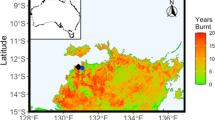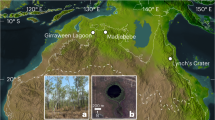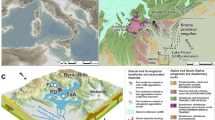Abstract
Remote islands in the Pacific Ocean (Oceania) experienced dramatic environmental transformations after initial human settlement in the past 3,000 yr. Here, human causality of this environmental degradation has been unquestioned and viewed as evidence of the inherent destructive tendencies of human societies in both archaeological and popular discourse. We use charcoal and stable carbon isotopes from deep soil cores to reconstruct the dynamics of fire activity and deforestation across the Sigatoka River valley on the leeward (dry) side of Viti Levu, Fiji. Fires and pyrogenic patches of grassland predated human settlement by millennia, but the magnitude of fire activity and landscape transformation accelerated with the establishment and expansion of swidden agriculture. Regional comparisons with previous studies in Fiji and elsewhere in Remote Oceania settled between 3,200 and 2,900 yr bp reveal a similar pattern of pre- and post-settlement fire activity and landscape change. Pre-settlement fires generally corresponded to droughts, probably driven by El Niño, often correlating with drought-driven wildfires elsewhere in the region. Post-settlement, charcoal and C4 grasses increased dramatically, but nearly all major peaks in charcoal and grasses corresponded to increased El Niño activity. This indicates that fire activity and deforestation were a product of the interaction between swidden agriculture and climate rather than land use alone.
This is a preview of subscription content, access via your institution
Access options
Access Nature and 54 other Nature Portfolio journals
Get Nature+, our best-value online-access subscription
$29.99 / 30 days
cancel any time
Subscribe to this journal
Receive 12 digital issues and online access to articles
$119.00 per year
only $9.92 per issue
Buy this article
- Purchase on Springer Link
- Instant access to full article PDF
Prices may be subject to local taxes which are calculated during checkout





Similar content being viewed by others
Data availability
All stratigraphic data presented in the main text and in Extended Data figures are available as Supplementary Data and via Figshare at https://doi.org/10.6084/m9.figshare.23989998.
References
Diamond, J. Collapse: How Societies Choose to Fail or Succeed Revised edn (Penguin, 2011).
Nogué, S. et al. The human dimension of biodiversity changes on islands. Science 372, 488–491 (2021).
Rolett, B. & Diamond, J. Environmental predictors of pre-European deforestation on Pacific islands. Nature 431, 443–446 (2004).
Schenk, A., Neuhäuser, M., Ruxton, G. D. & Bathke, A. C. Predictors of pre-European deforestation on Pacific islands: a re-analysis using modern multivariate non-parametric statistical methods. For. Ecol. Manage. 493, 119238 (2021).
Diamond, J. M. Archaeology: the environmentalist myth. Nature 324, 19–20 (1986).
Mooney, S. et al. Late Quaternary fire regimes of Australasia. Quat. Sci. Rev. 30, 28–46 (2011).
van der Werf, G. R. et al. Continental-scale partitioning of fire emissions during the 1997 to 2001 El Niño/La Niña period. Science 303, 73–76 (2004).
Page, S. et al. in Tropical Fire Ecology: Climate Change, Land Use, and Ecosystem Dynamics (ed. Cochrane, M. A.) 263–287 (Springer, 2009).
Rieth, T. & Cochrane, E. E. in The Oxford Handbook of Prehistoric Oceania (eds Cochrane, E. E. & Hunt, T. L.) 133–161 (Oxford Univ. Press, 2018).
Horrocks, M. & Nunn, P. D. Evidence for introduced taro (Colocasia esculenta) and lesser yam (Dioscorea esculenta) in Lapita-era (c. 3050–2500 cal. yr BP) deposits from Bourewa, southwest Viti Levu Island, Fiji. J. Archaeol. Sci. 34, 739–748 (2007).
Roos, C. I., Field, J. S. & Dudgeon, J. V. Anthropogenic burning, agricultural intensification, and landscape transformation in post-Lapita Fiji. J. Ethnobiol. 36, 535–553 (2016).
Moy, C. M., Seltzer, G. O., Rodbell, D. T. & Anderson, D. M. Variability of El Nino/Southern Oscillation activity at millennial timescales during the Holocene epoch. Nature 420, 162–165 (2002).
Sandweiss, D. H. et al. Archaeological climate proxies and the complexities of reconstructing Holocene El Niño in coastal Peru. Proc. Natl Acad. Sci. USA 117, 8271–8279 (2020).
Emile-Geay, J. et al. Links between tropical Pacific seasonal, interannual and orbital variability during the Holocene. Nat. Geosci. 9, 168–173 (2016).
Conroy, J. et al. Climate influences on water and sediment properties of Genovesa Crater Lake, Galápagos. J. Paleolimnol. 52, 331–347 (2014).
Anderson, A., Chappell, J., Gagan, M. & Grove, R. Prehistoric maritime migration in the Pacific islands: an hypothesis of ENSO forcing. Holocene 16, 1–6 (2006).
Murphy, B. F., Power, S. B. & McGree, S. The varied impacts of El Niño–Southern Oscillation on Pacific island climates. J. Clim. 27, 4015–4036 (2014).
Kumar, R., Stephens, M. & Weir, T. Rainfall trends in Fiji. Int. J. Climatol. 34, 1501–1510 (2014).
Mariani, M., Fletcher, M.-S., Holz, A. & Nyman, P. ENSO controls interannual fire activity in southeast Australia. Geophys. Res. Lett. 43, 10,891–10,900 (2016).
Fletcher, M.-S. et al. Changes in biomass burning mark the onset of an ENSO-influenced climate regime at 42° S in southwest Tasmania, Australia. Quat. Sci. Rev. 122, 222–232 (2015).
Yamamoto, M. et al. Tropical western Pacific hydrology during the last 6,000 years based on wildfire charcoal records from Borneo. Geophys. Res. Lett. 48, e2021GL093832 (2021).
McGree, S., Schreider, S. & Kuleshov, Y. Trends and variability in droughts in the Pacific Islands and Northeast Australia. J. Clim. 29, 8377–8397 (2016).
Iese, V. et al. Historical and future drought impacts in the Pacific islands and atolls. Clim. Change 166, 19 (2021).
D’Antonio, C. M. & Vitousek, P. M. Biological invasions by exotic grasses, the grass/fire cycle, and global change. Annu. Rev. Ecol. Syst. 23, 63–87 (1992).
Cochrane, M. A. Fire science for rainforests. Nature 421, 913–919 (2003).
Kirch, P. V. The Wet and the Dry: Irrigation and Agricultural Intensification in Polynesia (Univ. of Chicago Press, 1994).
Hope, G., Stevenson, J. & Southern, W. in The Early Prehistory of Fiji (eds Clark, G. & Anderson, A.) 63–86 (ANU E Press, 2009).
Anderson, A. et al. Times of sand: sedimentary history and archaeology at the Sigatoka Dunes, Fiji. Geoarchaeology 21, 131–154 (2006).
Field, J. S. Environmental and climatic considerations: a hypothesis for conflict and the emergence of social complexity in Fijian prehistory. J. Anthropol. Archaeol. 23, 79–99 (2004).
Nunn, P. & Petchey, F. Bayesian re-evaluation of Lapita settlement in Fiji: radiocarbon analysis of the Lapita occupation at Bourewa and nearby sites on the Rove Peninsula, Viti Levu Island. J. Pac. Archaeol. 4, 21–34 (2013).
Burley, D. V. & Edinborough, K. Discontinuity in the Fijian archaeological record supported by a Bayesian radiocarbon model. Radiocarbon 56, 295–303 (2014).
Schneider, T., Hampel, H., Mosquera, P. V., Tylmann, W. & Grosjean, M. Paleo-ENSO revisited: Ecuadorian Lake Pallcacocha does not reveal a conclusive El Niño signal. Glob. Planet. Change 168, 54–66 (2018).
Nichols, G. J., Cripps, J. A., Collinson, M. E. & Scott, A. C. Experiments in waterlogging and sedimentology of charcoal: results and implications. Palaeogeogr. Palaeoclimatol. Palaeoecol. 164, 43–56 (2000).
Scott, A. C. Charcoal recognition, taphonomy and uses in palaeoenvironmental analysis. Palaeogeogr. Palaeoclimatol. Palaeoecol. 291, 11–39 (2010).
Winkler, M. G. Charcoal analysis for paleoenvironmental interpretation: a chemical assay. Quat. Res. 23, 313–326 (1985).
Constantine, M. & Mooney, S. Widely used charcoal analysis method in paleo studies involving NaOCl results in loss of charcoal formed below 400 °C. Holocene 32, 1358–1362 (2022).
Nunn, P. D. & Kumar, R. Alluvial charcoal in the Sigatoka Valley, Viti Levu Island, Fiji. Palaeogeogr. Palaeoclimatol. Palaeoecol. 213, 153–162 (2004).
Marlon, J. R. et al. Global biomass burning: a synthesis and review of Holocene paleofire records and their controls. Quat. Sci. Rev. 65, 5–25 (2013).
Hunter-Anderson, R. Savanna anthropogenesis in the Mariana Islands, Micronesia: re-interpretation of the palaeoenvironmental data. Archaeol. Ocean. 44, 125–141 (2009).
Athens, J. S. & Ward, J. V. in A Pacific Odyssey: Archaeology and Anthropology in the Western Pacific. Papers in Honour of Jim Specht Records of the Australian Museum, Suppl. 29 (eds Attenbrow, V. J. & Fullagar, R.) 15–30 (Australian Museum, 2004).
Åkesson, C. M. et al. 2,100 years of human adaptation to climate change in the High Andes. Nat. Ecol. Evol. 4, 66–74 (2020).
Bush, M. B., Correa-Metrio, A., van Woesik, R., Shadik, C. R. & McMichael, C. N. H. Human disturbance amplifies Amazonian El Niño–Southern Oscillation signal. Glob. Change Biol. 23, 3181–3192 (2017).
Gosling, W. D. et al. Human occupation and ecosystem change on Upolu (Samoa) during the Holocene. J. Biogeogr. 47, 600–614 (2020).
Kirch, P. V. Man’s role in modifying tropical and subtropical Polynesian ecosystems. Archaeol. Ocean. 18, 26–31 (1983).
Conroy, J. L., Overpeck, J. T., Cole, J. E., Shanahan, T. M. & Steinitz-Kannan, M. Holocene changes in eastern tropical Pacific climate inferred from a Galápagos lake sediment record. Quat. Sci. Rev. 27, 1166–1180 (2008).
van Wagtendonk, J. W. & Cayan, D. R. Temporal and spatial distribution of lightning strikes in California in relation to large-scale weather patterns. Fire Ecol. 4, 34–56 (2008).
Ramachandran, V., Kishore, A. & Kumar, S. Mapping the cloud-to-ground lightning occurrence in Fiji. South Pac. J. Nat. Appl. Sci. 24, 32–37 (2006).
Dai, A. & Wigley, T. M. L. Global patterns of ENSO-induced precipitation. Geophys. Res. Lett. 27, 1283–1286 (2000).
Roos, C. I., Zedeño, M. N., Hollenback, K. L. & Erlick, M. M. H. Indigenous impacts on North American Great Plains fire regimes of the past millennium. Proc. Natl Acad. Sci. USA 115, 8143–8148 (2018).
Lilley, I. Apocalypse now (and avoid the rush): human dimensions of climate change in the Indo-Pacific. Archaeol. Ocean. 43, 35–40 (2008).
McAnany, P. A. & Yoffee, N. Questioning Collapse: Human Resilience, Ecological Vulnerability, and the Aftermath of Empire (Cambridge Univ. Press, 2009).
D’Antonio, C. M., Hughes, R. F. & Tunison, J. T. Long-term impacts of invasive grasses and subsequent fire in seasonally dry Hawaiian woodlands. Ecol. Appl. 21, 1617–1628 (2011).
Freifelder, R. R., Vitousek, P. M. & D’Antonio, C. M. Microclimate change and effect on fire following forest-grass conversion in seasonally dry tropical woodland. Biotropica 30, 286–297 (1998).
Nunn, P. D. Recent environmental changes on Pacific islands. Geogr. J. 156, 125–140 (1990).
Cai, W. et al. More extreme swings of the South Pacific convergence zone due to greenhouse warming. Nature 488, 365–369 (2012).
Schoeneberger, P. J., Wysocki, D. A., Benham, E. C. & Soil Survey Staff. Field Book for Describing and Sampling Soils Version 3.0 (Natural Resources Conservation Service, National Soil Survey Center, 2012).
Janitsky, P. in Field and Laboratory Procedures Used in a Soil Chronosequence Study (eds Singer, M. & Janitsky, P.) 11–16 (United States Government Printing Office, 1986).
Roos, C. I. et al. Native American fire management at an ancient wildland-urban interface in the southwest United States. Proc. Natl Acad. Sci. USA 118, e2018733118 (2021).
Cao, H., Huang, X. & Xiang, L. Soil erosion caused the increasing Holocene radiocarbon reservoir effect of Lake Kanas in the Altai Mountains. Radiocarbon 65, 343–356 (2023).
Hogg, A. G. et al. SHCal20 Southern Hemisphere calibration, 0–55,000 years cal BP. Radiocarbon 62, 759–778 (2020).
Blaauw, M. & Christen, J. A. Flexible paleoclimate age-depth models using an autoregressive gamma process. Bayesian Anal. 6, 457–474 (2011).
Acknowledgements
We thank the staff of the Fiji Museum, especially R. J. Balenaivalu for contributing to fieldwork; the Roko Tui of Nadroga-Navosa Province, V. Burenivalu, and the district officer of Navosa, J. Manweli; the communities and villages of Nayawa, Naduri, Vatubalavu, Tawatawadi and Koronisagana for granting us permission to core on their lands; and A. Commendador, M. Aiuvalasit and A. Figueroa for assistance with field and/or lab work. This research was supported by grants from the National Science Foundation BCS-1216312, BCS-1216330 and BCS-1216310. Comparative data were obtained from the Global Charcoal Database (http://www.paleofire.org), and the work of the data contributors and the Global Palaeofire Working Group is gratefully acknowledged.
Author information
Authors and Affiliations
Contributions
C.I.R., J.S.F. and J.V.D. conceptualized the project, acquired funding and conducted investigations. C.I.R. curated data, conducted formal analysis, developed the methodology, administered the project together with J.S.F., performed visualization and wrote the original draft of the manuscript. All authors reviewed and edited the manuscript.
Corresponding author
Ethics declarations
Competing interests
The authors declare no competing interests.
Peer review
Peer review information
Nature Ecology & Evolution thanks S. Mooney, Mark Bush and the other, anonymous, reviewer(s) for their contribution to the peer review of this work.
Additional information
Publisher’s note Springer Nature remains neutral with regard to jurisdictional claims in published maps and institutional affiliations.
Extended data
Extended Data Fig. 1 Stratigraphic data for the Caluwe core.
Stratigraphic data for the Caluwe Creek locality (CAL). Calibrated radiocarbon dates shown are only those used in the age depth model (Extended Data Fig. 6).
Extended Data Fig. 2 Stratigraphic data for the Caqasi core.
Stratigraphic data for the Caqasi Creek locality (CAQ). Calibrated radiocarbon dates shown are only those used in the age depth model (Extended Data Fig. 7).
Extended Data Fig. 3 Stratigraphic data for the Qaraqara 1 core.
Stratigraphic data for the Qaraqara Creek locality 1 (QAR 1), the older alluvial terrace. Calibrated radiocarbon dates shown are only those used in the age depth model (Extended Data Fig. 8).
Extended Data Fig. 4 Stratigraphic data for the Qaraqara 4 core.
Stratigraphic data for the Qaraqara Creek locality 4 (QAR 4), the younger alluvial terrace. Calibrated radiocarbon dates shown are only those used in the age depth model (Extended Data Fig. 9).
Extended Data Fig. 5 Stratigraphic data for the Tuwalu core.
Stratigraphic data for the Tuwalu Creek locality (TUW). Calibrated radiocarbon dates shown are only those used in the age depth model (Extended Data Fig. 10).
Extended Data Fig. 6 Age-depth model for the Caluwe Creek locality (CAL).
Calibrated ages used in the model are in blue. Calibrated ages for reworked, older, rejected dates are in red. A post-bomb date from the plowzone is not shown. Neither is a radiocarbon infinite date on charcoal from the Ab1 soil as it could not be plotted at this scale. Error lines indicate 95% confidence interval (CI) calibrated dates. Rectangles indicate 68% CI calibrated date ranges.
Extended Data Fig. 7 Age-depth model for the Caqasi Creek locality (CAQ).
Calibrated ages used in the model are in blue. Calibrated ages for reworked, older, rejected dates are in red. Error lines indicate 95% confidence interval (CI) calibrated dates. Rectangles indicate 68% CI calibrated date ranges.
Extended Data Fig. 8 Age-depth model for the Qaraqara Creek locality 1 (QAR 1), the older alluvial terrace.
Calibrated ages used in the model are in blue. Calibrated ages for reworked, older, rejected dates are in red. Error lines indicate 95% confidence interval (CI) calibrated dates. Rectangles indicate 68% CI calibrated date ranges.
Extended Data Fig. 9 Age-depth model for the Qaraqara Creek locality 4 (QAR 4), the younger alluvial terrace.
Calibrated ages used in the model are in blue. Calibrated ages for reworked, older, rejected dates are in red. Error lines indicate 95% confidence interval (CI) calibrated dates. Rectangles indicate 68% CI calibrated date ranges.
Extended Data Fig. 10 Age-depth model for the Tuwalu Creek locality (TUW).
Calibrated ages used in the model are in blue. Calibrated ages for reworked, older, rejected dates are in red. Error lines indicate 95% confidence interval (CI) calibrated dates. Rectangles indicate 68% CI calibrated date ranges.
Supplementary information
Supplementary Data 1
Excel file with separate spreadsheets for (1) locations of coring localities, (2) all charcoal and isotope data binned at 50-yr intervals, (3) all radiocarbon data and (4) and all stratigraphic data for each coring locality.
Rights and permissions
Springer Nature or its licensor (e.g. a society or other partner) holds exclusive rights to this article under a publishing agreement with the author(s) or other rightsholder(s); author self-archiving of the accepted manuscript version of this article is solely governed by the terms of such publishing agreement and applicable law.
About this article
Cite this article
Roos, C.I., Field, J.S. & Dudgeon, J.V. Fire activity and deforestation in Remote Oceanian islands caused by anthropogenic and climate interactions. Nat Ecol Evol 7, 2028–2036 (2023). https://doi.org/10.1038/s41559-023-02212-8
Received:
Accepted:
Published:
Issue Date:
DOI: https://doi.org/10.1038/s41559-023-02212-8



